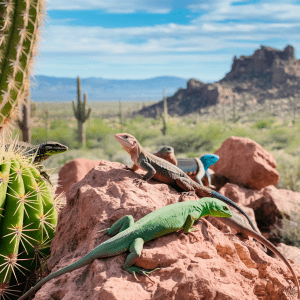Introduction: Understanding Mountain Lizard Adaptation Strategies
Have you ever wondered how mountain lizards manage to thrive in their challenging habitats? These incredible creatures have developed some mind-boggling adaptation strategies that will leave you in awe.
Picture this – a mountain lizard blending seamlessly into the rocky terrain, almost invisible to predators. Their physical adaptations are truly remarkable. But it’s not just about camouflage; these lizards have some clever behavioral tricks up their sleeves too.
Did you know that some mountain lizards can adjust their body temperature to the surrounding environment with incredible precision? It’s like having a built-in thermostat! This ability helps them survive in extreme mountain climates.
Imagine being a mountain lizard, navigating your rocky home with ease, using your specialized limbs to climb and cling effortlessly. Their evolutionary journey is a fascinating tale of survival and adaptation in the face of adversity.
Now, here’s a thought-provoking question – how might climate change impact these resilient mountain lizards and their adaptation strategies? The changing environment poses new challenges that these creatures must overcome to ensure their survival.
As we delve deeper into the world of mountain lizard adaptation strategies, we uncover not just scientific marvels but also valuable insights into the delicate balance of nature. These tiny reptiles hold secrets that could teach us a great deal about resilience and adaptation in the face of adversity.
Importance of Adaptation in Mountain Environments
Imagine walking through the rugged terrain of a mountain range, surrounded by the awe-inspiring beauty of nature. As you navigate the rocky paths and observe the diverse flora and fauna around you, have you ever stopped to think about the incredible adaptations of mountain lizards?
These fascinating creatures have evolved unique physical features and behavioral strategies to thrive in the challenging mountain environment. Picture this: a mountain lizard blending seamlessly into its surroundings, thanks to its camouflaged scales that help it evade predators and hunt for prey effectively.
Intriguingly, mountain lizards have also developed specialized behaviors to cope with the harsh conditions of their habitat. From basking in the sun to regulate their body temperature to seeking shelter in crevices during inclement weather, these adaptive behaviors showcase the incredible resilience of these reptiles.
Consider this: did you know that some mountain lizards can change their color based on environmental factors? This remarkable ability not only aids in camouflage but also serves as a form of communication with other lizards in their social group.
As you delve deeper into the world of mountain lizard adaptation strategies, you’ll begin to appreciate the intricate balance between survival instincts and environmental challenges. What other secrets do these elusive creatures hold, waiting to be unveiled through further research and exploration?
So, the next time you venture into the mountains, take a moment to observe the hidden world of mountain lizards and marvel at the wonders of nature’s adaptive brilliance.
Physical Adaptations of Mountain Lizards
When it comes to the physical adaptations of mountain lizards, you are in for a treat. These creatures have evolved some truly remarkable features to conquer their challenging environments. Just take a look at their specialized scales that help them blend seamlessly into the rocky terrains they call home. It’s like they have their own built-in camouflage suits! And let’s not forget their unique body shapes, perfectly suited for navigating the rugged mountain landscapes. Imagine having limbs and tails specifically designed for climbing steep cliffs and basking under the sun at high altitudes.
But here’s the kicker – did you know that some mountain lizards can change their color based on their surroundings? It’s like having a superpower that allows them to adapt instantly to different environments. Picture this: a lizard blending in effortlessly with the greenery one moment and seamlessly matching the rocky terrain the next. It’s nature’s very own chameleon show!
Now, think about how these physical adaptations not only help mountain lizards survive but also thrive in their harsh habitats. It raises the question – how can such small creatures be so incredibly well-adapted to their surroundings? It’s a fascinating glimpse into the wonders of evolution and the incredible diversity of life on our planet. So next time you spot a mountain lizard, take a moment to appreciate the extraordinary adaptations that make them truly remarkable creatures of the wild.
Behavioral Strategies for Survival
Have you ever wondered how mountain lizards manage to survive and thrive in their harsh environments? These incredible creatures have developed a range of physical adaptations and behavioral strategies that help them conquer the challenges of mountain life.
Imagine this – picture a mountain lizard blending seamlessly into its rocky surroundings, its coloration providing the perfect camouflage. This is just one of the many ways these reptiles have evolved to evade predators and capture prey.
Mountain lizards are also masters of temperature regulation, using their environment to their advantage. By basking in the sun to warm up or seeking shade to cool down, they can maintain their ideal body temperature even in extreme conditions.
But it’s not just about physical adaptations – their behavior plays a crucial role in their survival too. From choosing the right times to forage for food to finding the safest places to rest, mountain lizards have honed their instincts over generations.
Have you ever wondered how mountain lizards communicate with each other? Despite their solitary nature, these reptiles have developed unique ways to interact, ensuring their survival in a challenging environment.
As we delve deeper into the world of mountain lizard adaptation strategies, we begin to appreciate the incredible resilience and ingenuity of these fascinating creatures. Stay tuned to learn more about the evolutionary wonders of mountain lizards and the secrets they hold.
Evolutionary Aspects of Mountain Lizard Adaptations
Mountain lizards are masters of adaptation, constantly evolving to thrive in their challenging mountain habitats. Their physical features, like specialized scales for camouflage, help them blend seamlessly into rocky terrains. But it’s not just about looks; these reptiles have some fascinating behaviors too. For instance, did you know that some mountain lizards can change their body temperature to match their surroundings? It’s like having a built-in thermostat! This ability allows them to remain active and hunt efficiently even in extreme mountain climates.
Mountain lizards face various challenges in their environment, from harsh weather conditions to predators lurking around every corner. Yet, they have developed unique survival strategies to overcome these obstacles. One such strategy is their exceptional agility and speed, enabling them to swiftly navigate the rugged terrain and escape potential threats.
Have you ever wondered how mountain lizards communicate with each other in such vast mountain landscapes? Their communication methods may not involve words, but they rely on subtle body language and intricate movements to convey messages. Observing these behaviors in the wild can provide valuable insights into the social dynamics of mountain lizard communities.
As we delve deeper into the world of mountain lizard adaptation strategies, we begin to appreciate the resilience and complexity of these remarkable creatures. What other remarkable adaptations do mountain lizards possess that are yet to be discovered? The more we learn about these fascinating reptiles, the more we realize how interconnected all species are in the intricate web of nature.
Impact of Climate Change on Adaptation Strategies
Mountain lizards are truly fascinating creatures, especially when it comes to their adaptation strategies in mountain environments. These reptiles have evolved over time to conquer the challenges of rocky terrains and fluctuating temperatures.
Let me share a personal anecdote to illustrate the incredible resilience of mountain lizards. Imagine hiking up a steep mountain trail, feeling the crisp air and admiring the breathtaking views. Suddenly, you spot a mountain lizard effortlessly navigating the rugged terrain, blending seamlessly into its surroundings. It’s a moment of awe and wonder at nature’s marvels.
Mountain lizards have developed remarkable physical adaptations to thrive in their harsh habitats. Their ability to change color to match the rocks and vegetation around them is like a living camouflage cloak. Additionally, their agile climbing skills and keen senses help them elude predators and hunt for food effectively.
But here’s a thought-provoking question: How do mountain lizards cope with the increasing impact of climate change on their habitats? As temperatures rise and habitats shift, these resilient creatures face new challenges to adapt and survive. Understanding their strategies can provide insights into broader ecological changes and conservation efforts.
As we delve deeper into the world of mountain lizard adaptation strategies, we uncover a tapestry of evolutionary marvels and survival tactics that inspire awe and admiration. The next time you spot a mountain lizard on your outdoor adventures, take a moment to appreciate the intricate adaptations that make these reptiles true masters of their mountain realms.
Interactions with Other Species in the Mountain Ecosystem
Mountain lizards are not solitary creatures; they interact with various species in their mountain ecosystem. These interactions play a crucial role in shaping their adaptation strategies and overall survival. Imagine a bustling community of mountain lizards, each playing a unique role in the intricate web of relationships within their habitat. From hunting for prey to avoiding predators, these interactions are essential for their daily existence.
Consider the fascinating dynamic between mountain lizards and their prey. It’s a constant game of predator versus prey, where each side must adapt and evolve to outsmart the other. The mountain lizard’s ability to camouflage itself or swiftly catch its prey showcases the intricate dance of survival in the wild.
Furthermore, the relationships between mountain lizards and other species, such as birds or insects, offer a glimpse into the interconnectedness of nature. These interactions not only affect the mountain lizards but also have broader implications for the entire ecosystem.
As you delve deeper into the world of mountain lizard interactions, you’ll be amazed by the complexity and beauty of these relationships. It’s a reminder that every creature, no matter how small, plays a vital role in the delicate balance of nature.
Conservation Implications of Mountain Lizard Adaptations
Imagine the intricate web of mountain lizard adaptations, each a masterpiece of survival strategy. These creatures have evolved over millennia, sculpting their bodies and behaviors to navigate the challenges of their rugged habitats. But beyond their physical and behavioral adaptations lies a deeper layer of significance – the conservation implications of these remarkable feats of evolution.
When we delve into the world of mountain lizard adaptations, we uncover not just a story of resilience and ingenuity but also a pressing call to action. The delicate balance between these creatures and their environment is a testament to the interconnectedness of life on Earth. As mountain habitats face increasing threats from human activities and climate change, the adaptive strategies of mountain lizards serve as a poignant reminder of the fragility of our natural world.
Consider this – each adaptation, whether it be their color-changing abilities or specialized diet preferences, is a finely tuned response to the challenges they face. How can we, as stewards of the planet, ensure the continued survival of these incredible creatures? It’s a question that goes beyond the realm of biology and into the heart of our responsibility towards the environment.
As we marvel at the intricate dance of adaptation that mountain lizards perform, let us also reflect on our role in preserving the diversity and beauty of our planet. In the face of adversity, these creatures have found ways to thrive – can we do the same for them?
Future Research Directions in Studying Adaptation Strategies
Have you ever stopped to marvel at the incredible ways mountain lizards adapt to their environment? It’s truly mind-boggling. These creatures have perfected the art of survival in some of the harshest conditions on Earth. Picture this: a tiny lizard, perfectly camouflaged against the rocky terrain, basking in the sun. It’s a scene straight out of a wildlife documentary. But there’s more to their adaptations than meets the eye. Did you know that mountain lizards can adjust their body temperatures to cope with extreme cold or heat? It’s like having your own built-in thermostat! And that’s just scratching the surface. The evolutionary journey of these lizards is a tale of resilience and innovation. Think about it – how amazing is it that these creatures have developed such intricate strategies to thrive in their challenging mountain habitats? It makes you wonder: what other secrets do they hold? So next time you spot a mountain lizard on your hike, take a moment to appreciate the incredible adaptations that allow them to conquer the mountains. It’s a testament to the power of nature and the beauty of adaptation.
Conclusion: Appreciating the Resilience of Mountain Lizards
Mountain lizards are true marvels of evolution. These creatures have mastered the art of survival in the challenging mountain environments. Picture this: a tiny lizard navigating steep cliffs and rocky terrains with ease, thanks to its remarkable adaptation strategies.
One fascinating fact about mountain lizards is their ability to change color to blend seamlessly into their surroundings. It’s like having a built-in invisibility cloak! This camouflage helps them evade predators and hunt for prey effectively.
Imagine being a mountain lizard, facing the constant challenge of finding food and shelter in the harsh mountain landscape. These creatures have developed ingenious behavioral strategies to overcome these obstacles. From basking in the sun to regulate body temperature to seeking refuge in crevices during inclement weather, every move is a calculated survival tactic.
Have you ever wondered how climate change is impacting mountain lizards and their adaptation strategies? As temperatures shift and habitats transform, these resilient creatures face new challenges in their struggle for survival.
As an expert in mountain lizard adaptations, I find it fascinating to study the intricate ways in which these reptiles have evolved to thrive in their environment. The more we understand about their strategies, the better equipped we are to appreciate and conserve these remarkable creatures.




